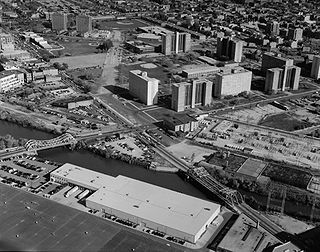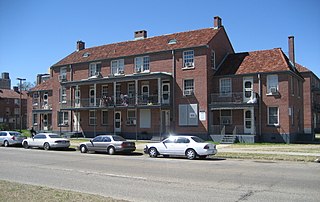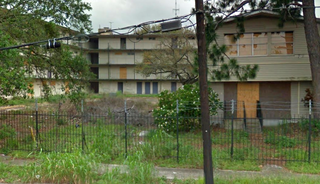Related Research Articles

Cabrini–Green Homes are a Chicago Housing Authority (CHA) public housing project on the Near North Side of Chicago, Illinois. The Frances Cabrini Rowhouses and Extensions were south of Division Street, bordered by Larrabee Street to the west, Orleans Street to the east and Chicago Avenue to the south, with the William Green Homes to the northwest.

Algiers is a historic neighborhood of New Orleans and is the only Orleans Parish community located on the West Bank of the Mississippi River. Algiers is known as the 15th Ward, one of the 17 Wards of New Orleans. It was once home to many jazz musicians and is also the second oldest neighborhood in the city.

St. Thomas Development was a notorious housing project in New Orleans, Louisiana. The project lay south of the Central City in the lower Garden District area. As defined by the City Planning Commission, its boundaries were Constance, St. Mary, Magazine Street and Felicity Streets to the north; the Mississippi River to the south; and 1st, St. Thomas, and Chippewa Streets, plus Jackson Avenue to the west. In the 1980s and 1990s, St. Thomas was one of the city’s most dangerous and impoverished housing developments. It made national headlines in 1992 after the deadly shooting of Eric Boyd. In 1982 Helen Prejean moved into the St. Thomas development in order to live and work with the poor. While there, Sister Helen began corresponding with Patrick Sonnier, who had been sentenced to death for the murder of two teenagers. After witnessing the executions, she sat down and wrote a book, Dead Man Walking. The book inspired the 1995 film Dead Man Walking. In 1998 the project was demolished and replaced with mixed income "River Garden."

The Magnolia Projects, later the C. J. Peete Public Housing Development, was one of the Housing Projects of New Orleans. The area has been more recently renamed Harmony Oaks as part of a complete HOPE VI redevelopment of the property. As a housing project, it was among the largest, housing approximately 2,100 people. It is also home to numerous hip-hop artists and is located in the part of uptown New Orleans known as Central City within the 11th Ward of New Orleans. It was bounded by Louisiana Avenue, South Claiborne Avenue, La Salle Street and Washington Avenue. The Magnolia Projects was made famous by rappers such as Juvenile, Soulja Slim, and Magnolia Shorty. At its height, the Magnolia projects had 1403 units.

The Housing Authority of New Orleans is a housing authority in New Orleans, Louisiana, tasked with providing housing to low-income residents.
Desire Projects was a housing project located in the Ninth Ward of New Orleans, Louisiana. These projects were the largest in the nation and consisted of about 262 two-story brick buildings, containing about 1,860 units across 98.5 acres of land. The overall conditions of the projects were deplorable from the moment they were put into place in the later part of the 1950s. The projects were meant to serve the large number of underprivileged African-American residents in the New Orleans area. Soon it became a place of despair, and Desire eventually evolved into a dark no-man's land, leaving many residents infested with problems and little or no help from the government. Located in a cypress swamp and dumping ground, Desire was known as the poorest housing development in New Orleans—it was bordered by railroad tracks, the Mississippi River, the Industrial Canal and a corridor of industrial plants.
Florida Avenue Projects or Florida Projects is a public housing project in the city of New Orleans. The development was built in 1946 on an 18.5-acre tract of land bounded by Florida Avenue and North Dorgenois, Mazant and Gallier streets in the Upper 9th Ward. It contained 47 two- and three-story brick buildings, arranged around courtyards and largely isolated from the rest of the community, for a total of 734 units housing 1,297 residents. Originally built for whites, it was later desegregated and by the 1970s was becoming predominantly a black project. In the mid-1990s, Florida and nearby Desire Projects were dubbed the most violent housing projects in the nation. In 1994, Florida recorded the highest homicide rate of all HANO developments, with 26 slayings, surpassing the 13 killings in Desire which previous held the highest record a year before. The majority of the Florida killings in 1994 were fueled by drug wars, specifically between the notorious Hardy Boys and the Poonie Crew. The homicide spike in Florida and Desire contributed to New Orleans being dubbed "the nation's murder capital". That year the city's homicide rate reached 424, 47 of those killings occurring in HANO developments.

St. Bernard Projects was a housing project in the city of New Orleans. A subdistrict of the Mid-City District Area, its boundaries as defined by the New Orleans City Planning Commission were: Harrison Avenue to the north, Paris Avenue to the east, Lafreniere Street and Florida Avenue to the south and Bayou St. John to the west.

The Melpomene Projects, officially called the Gustavo Apartments or TheGuste Homes, and colloquially The Melph, are a housing complex located in the Central City neighborhood of New Orleans.

Iberville Projects was a neighborhood in the city of New Orleans and one of the low-income Housing Projects of New Orleans. The Iberville was the last of the New Deal-era public housing remaining in the city. Its boundaries were St. Louis Street, Basin Street, Iberville Street, and North Claiborne Avenue. It is located in the 6th ward of downtown New Orleans, on the former site of the Storyville district. The area has recently been redeveloped into a modernized apartment complex called the Bienville Basin Apartments.

The William J. Fischer Housing Development, better known as the Fischer Projects, was a housing project in Algiers, New Orleans, Louisiana, United States. It was known notoriously for a series of high-profile murders in the 1970s and 1980s. It was the last conventional public housing development constructed in New Orleans, and one of the first to begin demolition. It originally consisted of a 13-floor high-rise and fourteen 3-floor units. The area has been undergoing redevelopment since about 2004 and currently none of the original low-rise buildings remain. The development is located along Whitney Avenue in the Algiers area of the city's west bank, which is part of the 15th Ward and is named for William J. Fischer who served as chairman of HANO in the 1950s. The property is now converted to a small low-income housing development.

The Chicago Housing Authority (CHA) is a municipal corporation that oversees public housing within the city of Chicago. The agency's Board of Commissioners is appointed by the city's mayor, and has a budget independent from that of the city of Chicago. CHA is the largest rental landlord in Chicago, with more than 50,000 households. CHA owns over 21,000 apartments. It also oversees the administration of 37,000 Section 8 vouchers. The current acting CEO of the Chicago Housing Authority is Tracey Scott.

Internally displaced persons in the United States are people from the Gulf States region in the southern United States, most notably New Orleans, Louisiana, who were forced to leave their homes because of the devastation brought on by Hurricane Katrina in 2005 and were unable to return because of a multitude of factors, and are collectively known as the Gulf Coast diaspora and by standard definition considered IDPs. At their peak, hurricane evacuee shelters housed 273,000 people and, later, FEMA trailers housed at least 114,000 households. Even a decade after Hurricane Katrina, many victims who were forced to relocate were still unable to return home.

Gert Town is a neighborhood in the city of New Orleans, Louisiana. It is the home to Xavier University of Louisiana and is near Mid-City. Gert Town played a major role in the industrial development of the New Orleans region. The Blue Plate Mayonnaise Factory, Coca-Cola Bottling Plant, Sealtest Dairy, and Thompson-Hayward Chemical Company were all fundamental manufacturing bases of the working-class neighborhood. Gert Town was also well known for being a center of development for jazz and other music genres. Musicians such as Buddy Bolden, John Robichaux, Merry Clayton, Bunk Johnson and Allen Toussaint all came from the neighborhood and helped shape the musical influence of New Orleans.

New Faubourg Lafitte is a residential development in New Orleans, Louisiana, U.S. It largely occupies the area formerly filled by the since demolished Lafitte Projects public housing.

DeGaulle Manor was a federally subsidized public housing complex in the Algiers neighborhood of New Orleans. The apartment complex was known for crime and was one of the oldest and most troubled apartment complexes in the city before being shut down in 2012. It later became a dumping ground for trash and in 2014, became a work of art as it was transformed into a graffiti display.
The Calliope Projects, also known as B. W. Cooper Public Housing Development, was a neighborhood of the city of New Orleans and one of the housing projects of New Orleans. This project of New Orleans gained notoriety for its extremely high violent crime rate. It was demolished in 2014 and replaced with newer, mixed-income apartment buildings.
Behrman also known as "Behrman Heights", is a community located in Algiers, New Orleans It was named after popular New Orleans mayor Martin Behrman, and is nestled south of the US Naval Support neighborhood and north of Tall Timbers/Brechtel, flanked on the west by Fischer Housing Development and Whitney, and on the east by Old Aurora.

The Lake Michigan High-Rises, also known as Lakefront Homes, was a Chicago Housing Authority (CHA) public housing project in the North Kenwood–Oakland neighborhood located in the South Side of Chicago, Illinois, United States. Constructed in 1962 and completed in 1963, The Lake Michigan High-Rises originally consisted of four 16–story buildings; totaling 457 units. The Lake Michigan High-Rises was located west of Lake Shore Drive and was included as a part of the CHA Lakefront Properties. Today, only two buildings of the Lakefront Properties exist; they were officially renamed from Victor Olander Homes to Lake Parc Place in 1991. The other four high–rises were demolished by implosion in December 1998, it was the first and only to date in Chicago Housing Authority history.

LaToya Cantrell is a politician serving as the Mayor of New Orleans, Louisiana since May 7, 2018. A Democrat, Cantrell is the first woman to hold the office. Before becoming mayor, Cantrell represented District B on the New Orleans City Council from 2012 to 2018.
References
- ↑ "Housing Authority approves new mixed-income developments in these New Orleans neighborhoods".
- ↑ "New Orleans, LA Local News, Breaking News, Sports & Weather - NOLA.com". nl.newsbank.com. Retrieved 2021-02-15.
- ↑ Board, The Times-Picayune Editorial. "Housing Authority of New Orleans wronged Christopher Park residents: An editorial". NOLA.com. Retrieved 2021-02-15.
- ↑ Gettleman, Jeffrey (2003-07-11). "New Orleans Struggles With a Homicide Rate That Belies Its Size (Published 2003)". The New York Times. ISSN 0362-4331 . Retrieved 2021-02-15.
- ↑ Advocate, The. "Politics | News from The Advocate". The Advocate. Retrieved 2021-02-15.